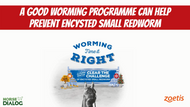Encysted Small Redworm in Horses - A hidden danger
Posted by Ben Watson on 23rd Oct 2013
Small Redworms (small strongyles) are the most common and harmful worms found in horses and whilst most wormers are effective against adult worms the larvae can become “encysted” after tunneling into the gut wall.
The stages of Encysed Small Redworm
A). Eggs are passed by the horse and develop into larvae - which is why picking up dung or sharing the grazing with sheep or cattle is important to reduce re-infection
B). The horse swallows the larvae while grazing and although some larvae grow into egg-laying adults in the large intestine around 85% tunnel into the gut wall and become “encysted” where they can remain for up to two years.
C). Thousands of larvae can emerge into the gut often at the end of the winter or in early spring and cause massive internal bleeding, colic or diarrhoea which can be fatal.
Treatment
Only three wormers can treat encysted stages of small redworm Equest as well as Equest Pramox (which also treats tapeworm) and Panacur Equine Guard, you can view all on this page. Treatment is best in the colder months during autumn and winter.
Worm egg counts
These can be useful as some horses require regular worming whilst others appear to have some resistance so that
treatment does not need to be so frequent. However these tests have their limitations as they can only indicate the number of egg-laying adults in the gut at that time. However as these encysted stages do NOT produce any eggs Faecal Egg Counts in horses may be negative but the first sign of any problem could be a horse that is seriously ill.
Our own laboratory carries out a great many worm egg counts and when discussing results with horse owners it is worrying to find that many are worming with ivermectin based treatments under the mistaken impression that this controls all stages of redworm.

